Kerala Plus One Physics Chapter Wise Previous Questions Chapter 9 Mechanical Properties of Solids
Question 1.
Elasticity is the property of matter that is characterized by atomic packing. For an elastic solid, stress applied is directly proportional to the strain produced in it. The stress versus strain graph for three materials A, B and C is shown below. (MARCH-2010)

a) Which is more elastic A, B or C? Justify your answer.
b) If the bulk modulus of water is 2 x 109Nm-2, find its compressibility.
c) Why are girders for supporting roofs formed in the shape of I?
Answer:
a) A. The strain of material A is smaller than that other materials.
(ie. If these materials are subjected to the same deforming force F, then extension of A will be less than B and C).
b)

Compressibility = 0.5 x 10-9 Pa-1
c) i) To avoid buckling
Question 2.
Elasticity is an internal property of matter. Fluids possess volume elasticity. Which is more elastic, air or water? Why? (MARCH-2011)
Answer:
Water is more elastic than air.
Question 3.
Elasticity is the property of a body by which it regains its original state on the removal of the deforming force. ‘
a) Why Steel is more elastic than Rubber? (MAY-2011)
b) The figure given below shows the stress-strain
curve for a given material. What are the Youngs modulus and approximate yield strength for this material?
Answer:

a) Youngs moduls of steel is larger than rubber. Hence steel is more elastic than rubber.
b)

Question 4.
When the pressure on a sphere s increased by 80 atmospheres, its volume decreases by 0.01%. Find the bulk modulus of elasticity of the material of the sphere. (MAY-2011)
Answer:
P = 80 x 105 Pa
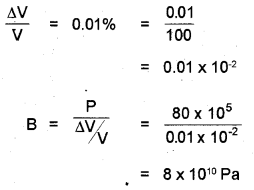
Question 5.
When a mass is suspended on a metallic wire, the length of the wire increases slightly. (MARCH-2012)
a) Name and state the law that relates to the restoring force developed in the wire and its deformation.
b) Draw the stress-strain graph of a loading wire. Mark the following points:
i) Elastic limit
ii) Fracture point
iii) Plastic region
iv) Elastic region
c) If the Young’s moduli of iron and glass are 190 x 109 Nm-2 and 65 x 109 Nm-2 respectively, which is more elastic ? Justify your answer.
Answer:
a) Hooks law.
For small deformations, the stress and strain are proportional to each other,
ie: stress ∝ strain
stress =k x strain.
Where k is the proportionality constant and is known as modulus of elasticity.
b) Stress strain curve
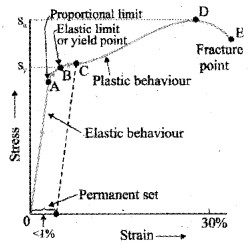
c) Iron is more elastic than glass, Because youngs, modulus of iron is more than glass.
For elastic material elongation (∆L) should be small, ie its youngs modulus will be high.
Young’s modulus ∝ \(\frac { 1 }{ elongation }\)
Question 6.
When a wire is stretched with a very large force it breaks. (MAY-2012)
a) Represent the variation of extension with load on a graph.
b) Discuss the behaviour of the wire at various stages.
c) State Hooke’s law. For which part of the above graph is this applicable.
d) Which is more elastic; steel or rubber? Why?
Answer:
a) Stress strain curve

b) Region OA
In the region between O to A, the curve is linear. Hence in this region Hooke’s law is obeyed. The body regains its original dimensions when the applied force is removed. In this region the mate-rial behaves as an elastic body.
Region AB
In this region stress and strain are not propor-tional. The material returns to its original dimension when the applied force (stress) is removed. The point B in the curve is known as yield point (also known as elastic limit) and corresponding stress is yield strength of the material.
Region BD
If the applied force exceeds the yield strength, strain increases rapidly for a small change in the stress. When the applied force (stress) is removed at ‘C’, the body does not regain it’s original dimension, (even when the stress is zero, the strain is not zero).
This deformation is said to be plastic deformation and the material is said to have a permanent set. The point D on the graph is the ultimate tensile strength (Su) of the material.
Region DE
Beyond this point D, additional strain is produced even by a reduced applied force and fracture occurs at the point E. Point E is called fracture point. If the ultimate strength (D) and fracture point (E) are close, the material is said to be brittle. If they are far apart, the material is said to be ductile.
c) Hooke’s law states that stress is proportional to strain.
In the region between O to A, the curve is linear. Hence in this region, Hooke’s law is obeyed. Steel is more elastic than rubber because for a given load steel expands less than rubber.
We have Y = \(\frac { F }{ A }\) \(\frac { l }{ ∆l }\)
for same force ∆lrubber is more than ∆lsteel
Ys>Yr
Question 7.
Hooke’s law states that stress a strain. (MARCH-2013)
a) What is the necessary condition for the above law to be valid?
b) Explain with the help of a graph, the relation between stress and strain for a given solid material under increasing tensile stress.
Answer:
a) For small values of strain.
b) Stress strain curve

Region OA
In the region between O to A, the curve is linear. Hence in this region Hooke’s law is obeyed. The body regains its original dimensions when the applied force is removed. In this region the mate-rial behaves as an elastic body.
Region AB
In this region stress and strain are not proportional. The material returns to its original dimension when the applied force (stress) is removed. The point B in the curve is known as yield point (also known as elastic limit) and corresponding stress is yield strength of the material.
Region BD
If the applied force exceeds the yield strength, strain increases rapidly for a small change in the stress. When the applied force (stress) is removed at ‘C’, the body does not regain it’s original dimension, (even when the stress is zero, the strain is not zero).
This deformation is said to be plastic deformation and the material is said to have a permanent set. The point D on the graph is the ultimate tensile strength (Su) of the material.
Region DE
Beyond this point D, additional strain is produced even by a reduced applied force and fracture oc-curs at the point E. Point E is called fracture point. If the ultimate strength (D) and fracture point (E) are close, the material is said to be brittle. If they are far apart, the material is said to be ductile.
c) Hooke’s law states that stress is proportional to strain.
In the region between O to A, the curve is linear. Hence in this region, Hooke’s law is obeyed. Steel is more elastic than rubber because for a given load steel expands less than rubber.
We have Y = \(\frac { F }{ A }\) \(\frac { l }{ ∆l }\)
for same force ∆lrubber is more than ∆lsteel
Ys>Yr
Question 8.
Stress-Strain graph of two materials is shown below:(MAY-2013)
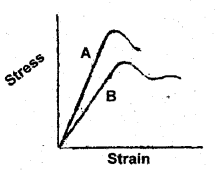
a) State the law which relates stress with strain.
b) Which material is more ductile (A or B)?
c) Which material is preferred for making springs (A or B)? Why?
Answer:
a) Hooks law states that within elastic limit the stress is directly proportional to strain.
b) The material B is more ductile. A material is ductile if there is a large plastic deformation between the elastic limit and fracture point. Material B is more ductile than material A.
c) The material having more Youngs modulus is used as spring. The slope of stress-strain graph gives Youngs modulus. In this case the material A gives more slope. Hence material A is preferred for making springs.
Question 9.
The graph below shows how the force applied to a metal wire is related to the extension of the wire. (MARCH-2014)
a) Write the letter that corresponds to:
i) Elastic limit.
ii) Fracture point
b) The wire has an unstretched length of 2.30m and an area of cross-section of 3.90 x 10-7m2. Determine the Young’s modulus Y of the material.
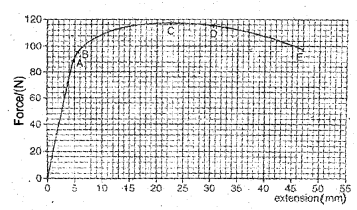
a) B is the elastic limit (TT) E is the fracture point
b) Youngs modulus Y
Answer:

Question 10.
When a force is applied to a spring, it gets extended by an amount Ax as shown. (MAY-2014)
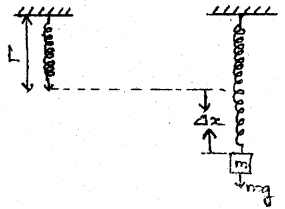
a) Name the law relating stress and strain.
b) Calculate the stress developed in a metal wire when it is strained by 30%. Given Young’s modulus of material is 200 GPa.
c) Which is more elastic, steel or rubber? Why?
Answer:
Hooke’s law
b) Strain = 30% = 3
Young’s modulus, Y = 200GPa

Question 11.
A rigid body is a body with a perfectly unchanging * shape under the influence of an external force. (MARCH-2015)
A rigid beam of length L, breadth b, and depth d is supported near its ends as shown in the figure. A load W is suspended at its center of mass. Write the expression for the amount of sagging.
Answer:
![]()
Question 12.
| Substance | Young’s modulus (N/m2) |
| X | 70 x 109 |
| Y | 120 x 109 |
| Z | 200 x 109 |
Young’s moduli of three materials are given in the above table. (MAY-2015)
a) What do you mean by Youngs’ modulus? Write a mathematical expression for it.
b) Select the material from the table, which shows more elasticity.
Answer:
a) Youngs modulus is the ratio of longitudinal stress to longitudinal strain.
y = \(\frac { Fl }{ ∆lA }\)
b) Z
Question 13.
The stress-strain graph for wires of two materials A and Bare given below. (MARCH-2016)
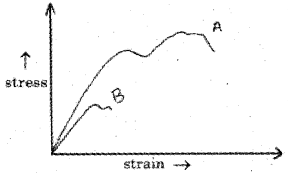
a) Which material is more ductile?
b) When spring balances are continuously used
for long time, the show wrong reading. Explain why.
Answer:
a) A
b) When spring balances are continuously used, it gradually loses its elasticity and shows the wrong reading.
Question 14.
a) The ratio of shear stress to shear strain is (MAY-2016)
i) Poisson’s ratio
ii) Young’s modulus
iii) Bulk modulus
iv) Rigidity modulus
b) State Hooke’s law.
Answer:
a) iv, Rigidity modulus
b) For small deformation stress is directly proportional to strain
Question 15.
A steel rod has a radius of 10 mm and a length of 1.0m. A 100 kN force stretches it along its length. Calculate the elongation of the steel rod. (MARCH-2017)
[Young’s modulus of steel is 2.0×1011N/m2]
OR
A metal cube of side 10 cm is subjected to shear stress 104 N/m2. Calculate the rigidity modulus, if the top of the cube is displaced by 0.05 cm with respect to its bottom.
Answer:

= 0.2 x 10 7 N/m2
